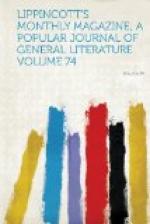The Parisian cab is not, like its London compeer, a prohibited pariah of a vehicle, excluded from parks or the court-yards of palaces. You can go to call at the Elysee or to attend a ball there in a cab if you like, and the Bois de Boulogne or the Pare Monceau is as free to that plebeian vehicle as to the landau of a prince. And if one attends a ball in Paris, there is no need to engage a carriage to return home in. Attracted by the lights, the cabmen station their vehicles in long lines in the neighborhood of any mansion where such a festivity is taking place, waiting patiently till three, four and five o’clock in the morning for a chance of conveying home some of the merrymakers. The only instance in which I ever heard of their failing to be on hand on such an occasion was at a large fancy ball where the German was kept up till six o’clock in the morning. The gay troupe issued forth into the golden glowing sunshine of the April morning, and found not a single cab in attendance; so powdered and brocaded Marquises, white-satin clad “Mignons,” Highlanders, Turks and Leaguers were forced to walk to their homes, in many instances miles away, to the immense amusement of the street-sweepers and naughty little boys, the only Parisians astir at that hour of the city’s universal repose.
L.H.H.
A NEW MUSEUM AT ROME.
A new museum of sculpture at Rome! One would have thought that it could hardly be needed. Besides three vast collections—that of the Lateran, that of the Capitol, and that wondrous world of antique sculpture at the Vatican, itself, in fact, three museums, and each of the three alone matchless in the world—we have the work of the hands that lived and worked here a couple of thousands of years ago in every villa, in every garden, almost at every corner. And yet we need, and have just established, another museum of ancient sculpture. We are now cutting new lines of streets—not, as you are doing, on the surface of a soil that has never been moved save by the forces of Nature since first the Creator divided the sea from the dry land, but—among the debris of the successive civilizations of more than three thousand years. The laying of our gas- and water-pipes breaks the painting on the walls of banquet-halls whose last revel was disturbed by the irruption of the barbarian. Our “main drainage” lies among the temples of gods whose godlike forms are found mutilated and prostrate among the fallen columns and tumbled architraves and cornices of their shrines.
But if no awe of the mighty past prevents the speculator and contractor of our day from marching his army of excavators in an undeviating and unyielding line impartially athwart the temples, the palaces, the theatres, the baths of the perished world beneath their feet, yet in these days of ours the work is done reverently, at least so far as not only to respect, but to gather up with the most scrupulous care, every available




